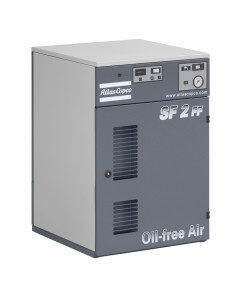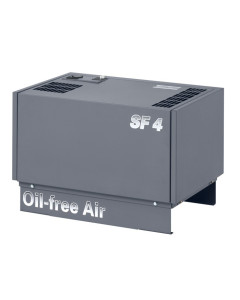Scroll Compressors: Silent Efficiency and Clean Air
Introduction
Compressed air is the "fourth industrial utility", alongside electricity, steam and process water. However, not all compression technologies equally meet today's demands for energy efficiency, low acoustic emissions and air quality. In food & beverage plants, pharmaceutical laboratories, precision workshops and automotive assembly lines, scroll compressors (or spiral compressors) are gaining ground thanks to their oil-free design, extremely quiet operation and reduced maintenance requirements.
This article, prepared by industrial pneumatics specialists and optimised for UK professionals, explores the operating principle, competitive advantages, selection criteria and integration of scroll compressors in compressed air systems. If you're deciding between investing in a new piston, screw or scroll type compressor, you'll find here a practical guide based on ISO standards, performance data and best practices from UK engineers.
How does a scroll compressor work?
The heart of a scroll compressor consists of two helical spirals: one remains fixed whilst the other describes an eccentric orbital movement without rotating on its own axis. As the moving spiral traces its orbit, atmospheric air becomes trapped in progressively smaller gas pockets that move towards the centre of the assembly. There it reaches discharge pressure and is evacuated continuously, without the cyclical pulsations typical of reciprocating compressors.
The absence of intake and exhaust valves, rings or connecting rods dramatically reduces internal friction and consequently mechanical losses. Modern scroll compressors achieve isentropic efficiencies of up to 72% at full load conditions, positioning them above many piston machines and just below the best lubricated screws. In oil-free versions, the heads are manufactured with advanced graphite and PTFE coatings that eliminate the need for lubricant within the compression chamber.
For applications with variable demand, modular configurations with several scroll heads mounted in parallel are common. The master controller switches each module on or off according to pressure, avoiding frequent start cycles of a single compressor and providing practically "stepped" regulation, similar to that of a variable speed drive (VSD). The result is competitive specific consumption (kWh/m³) even at partial load.
Advantages and limitations compared to other technologies
When evaluating options, the comparison usually includes piston, screw and scroll compressors. Below are the key advantages of scroll along with some limitations worth considering.
Advantages
- Low noise level: With sound enclosure, emission is between 55 and 62 dB(A) at 1 m. This allows installing the equipment within the production area without disturbing operators—an increasingly demanded solution in plants with space restrictions.
- 100% oil-free air: Oil-free models achieve Class 0 of ISO 8573-1 standard, eliminating contamination risks in food, pharmaceuticals or paint applications.
- Minimal vibration: Less vibration means reduced wear on fittings, pipework and foundations, extending the life of the pneumatic system.
- Elementary maintenance: A typical scroll has only two or three critical static seals and lacks valve plates. This reduces spare parts requirements and labour compared to pistons.
- High partial load efficiency: Thanks to sequential head shutdown, the scroll maintains almost linear specific consumption from 20% to 100% of nominal capacity.
- Unlimited starts: Peak current consumption is low and moving mass minimal, allowing frequent restarts without penalising motor life.
Limitations
- Moderate flow rate: Scroll technology typically covers 2 – 30 kW (0.2 – 4 m³/min). For intensive production (> 10 m³/min), screw compressors remain the reference option.
- Initial price: Acquisition cost per kW is higher than a standard piston. However, Total Cost of Ownership (TCO) balances with energy savings and reduced maintenance.
- Sensitivity to impurities: Abrasive dust can damage the spirals; a high-efficiency inlet filter is essential (at least M5 according to EN 779).
Key Takeaways: Advantages and limitations
- Scroll = quiet, oil-free and efficient at partial load.
- Flow rate limited to approx. 4 m³/min; beyond this a screw is preferable.
- Simple maintenance but requires clean inlet air filtration.
Common applications in the UK
Demand for scroll compressors is growing in sectors where silence, purity and efficiency are critical. Below are specific use cases observed in UK installations:
Food industry
Flow-pack packaging machines, PET blow moulders and dairy lines require air without oil traces to prevent hydrocarbon migration to the final product. An oil-free scroll paired with a refrigeration dryer + 0.01 µm filtration ensures compliance with HACCP and BRC standards.
Pharmaceutical and healthcare
Private hospitals across London use redundant scroll compressors in medical air banks. The dual spiral provides low pulsation and vibration, vital for respiratory and surgical equipment. Additionally, being oil-free, they eliminate hydrocarbon risk, complying with the European Pharmacopoeia.
Electronics and semiconductors
ISO 6 clean rooms for SMT assembly require dry air (< -40°C dew point) and oil-free. The scroll, combined with an adsorption dryer, exceeds these specifications with lower energy consumption than VSD micro-screws in the 7 – 15 kW range.
Automotive
In robotic paint lines, any oil droplet causes surface defects. Scroll compressors are installed as the "clean pole" for the paint booth, whilst a screw compressor lubricates less critical processes in the same facility. This segmentation reduces overall CAPEX and protects finish quality.
Laboratories and universities
R&D departments use small scroll units (2 kW) for mass spectrometers or electron microscopes. They're often installed directly under benches without requiring a technical room.
Step-by-step selection guide
Correct selection avoids oversizing, saves energy and guarantees process continuity. The following five-stage methodology has proven effective in energy audits conducted by Pneumatig in Birmingham, Manchester and Glasgow.
1. Demand analysis
Record pressure and flow consumption for one week with a data-logger. Identify peaks, valleys and simultaneity factor of pneumatic equipment. If data unavailable, sum nominal consumptions and multiply by 0.6 – 0.8 to estimate real simultaneity; add 20% for future growth.
2. Air quality definition
Determine required ISO 8573-1 class. For electronics and food, Class 0 oil, Class 2 particles and Class 2 water are required. This determines compressor choice (oil-free), dryer and filters.
3. Optimal pressure selection
Reducing pressure by 1 bar decreases consumption by up to 7%. Re-evaluate points of use: many ISO 6432 cylinders can work at 6 bar instead of 7. Adapt them with local FRL units and compensate the global reduction.
4. Technology comparison and TCO
For the 2-30 kW band, compare scroll, VSD screw and oil-free piston:
| Technology | CAPEX | Noise | 5-year OPEX* | Typical application |
|---|---|---|---|---|
| Oil-free scroll | Medium-high | < 60 dB(A) | ± £30/MWh saved | Clean and quiet air |
| VSD screw | High | 65-70 dB(A) | Similar savings, higher flow | Fluctuating demand > 4 m³/min |
| Oil-free piston | Low-medium | 75-85 dB(A) | High maintenance | Low utilisation, laboratory |
*Estimated calculation with electricity tariff £0.10/kWh and 4,000 h/year.
5. Tank and control sizing
A tank volume ≥ 4 s × Q (where Q = nominal flow) is recommended. This dampens peaks and reduces starts. A master controller can manage several scroll heads for multi-shift profiles.
Key Takeaways: Selection
- Record real data before sizing.
- Oil-free scroll = Class 0 ISO 8573-1.
- 1 bar less = up to 7% electrical savings.
- Tank ≥ 4 s of load ensures stability.
Integration into compressed air systems
The compressor is only the beginning of the chain. To protect it and guarantee air quality to the point of use, follow these integration best practices:
Drying and filtration
- Refrigeration dryers: Effective down to +3°C dew point. Suitable for most workshops and packaging. See refrigeration models.
- Adsorption dryers: Provide -40°C or -70°C for electronics and pharma applications.
- High efficiency filters: 1 µm pre-filter, 0.01 µm coalescing filter and activated carbon filter if odour removal required.
Piping and fittings
Aluminium piping such as AirNet or Transair reduces pressure drops by 30% compared to galvanised steel and simplifies extensions. Combine with quick-connect fittings certified for 13 bar.
Instrumentation and control
- Digital pressure gauges EN 837-1 Class 1.0 to monitor actual pressure.
- Flow sensors with 4-20 mA output to detect leaks and calculate energy KPIs (m³/kWh).
- Modbus/TCP connection for BMS or Industry 4.0 integration.
Condensate management
Install electronic drains without losses and condensate separators with oleo-hydrophilic cartridge to comply with UK environmental regulations.
Maintenance, reliability and total cost of ownership
The maintenance plan for a scroll compressor consists of four main tasks:
- Inlet filter: Replace every 2,000 h or when ΔP > 150 mbar.
- Belt and pulley (if applicable): Check tension and alignment every 4,000 h.
- Power electronics: Clean VSD drive annually, check connections.
- Scroll head: Reconditioning at 10,000 h (axial clearance and sealing). Pneumatig offers OEM kits and on-site assistance.
In a TCO analysis comparing a 7.5 kW oil-free piston with an equivalently sized scroll, Pneumatig observed 17% energy savings and 43% maintenance cost reduction over five years, justifying the higher initial investment.
Why choose Pneumatig?
As a pneumatics specialist e-commerce platform, Pneumatig combines catalogue, advisory and logistics to guarantee your project's success:
- UK stock: Warehouses in Birmingham and London with 24-48 h delivery across the UK.
- Application engineering: Our technicians (IMechE qualified) size flow, tank and filtration according to ISO 8573-1 and UK standards.
- Extended warranty: Up to 3 years for scroll equipment registered online.
- Flexible financing: Technology leasing at 36/60 months with purchase option.
- 24/7 spare parts portal: Identify and purchase filters, compressor parts and accessories without delays.



Login and Registration Form